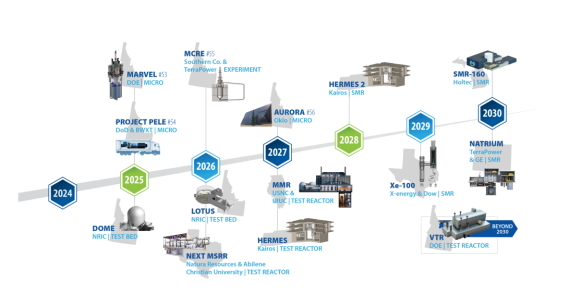US nuclear labs look forward to a busy year
Nuclear laboratories in the United States are gearing up for a busy 2024 as momentum grows for new capacity.

Related Articles
The United States Department of Energy (DOE) boasts 17 national laboratories, though the Idaho National Laboratory (INL) stands out as one of the most advanced nuclear research and development facilities in the country, if not the world.
Located on an 890-square-mile (2,305-square-kilometer) site, INL has built and operated 52 nuclear reactors in its 70 years of work and says that more than 300 commercial nuclear reactors around the world can trace their roots to the lab.
More than 6,100 people work at the lab and, with 235 active patents and a 2022 budget of $1.6 billion, the lab is involved in almost every aspect of nuclear innovation in the country.
INL currently runs four test reactors at the site, but it has been fifty years since a new, unique reactor began operations there.
That, according to Laboratory Director John Wagner, is about to change.
“For INL, I’m looking for major progress in all of the key areas in support of new nuclear, existing plants, and the front end of the fuel cycle,” says Wagner.
Work must begin on issues of supply chains, fuel cycles, licensing, and the workforce, he says.
“We've got to stop talking about and designing new nuclear reactors on computers and start building some.”
Over the next ten years, over a dozen advanced reactor concepts including microreactors, small modular reactors (SMRs), and university test reactors will be demonstrated in the United States, something Wagner says would have been unthinkable just a decade ago.
On the back of growing public support for nuclear power amid rising awareness of carbon emissions’ impact on climate and concerns over energy supply chains, INL is poised to be at the front of that movement.
Real world orders
At the end of July, the Westinghouse AP1000 Generation III+ reactor Vogtle Unit 3 entered commercial operation, the first newly constructed reactor in the United States in almost 30 years.
When Vogtle Unit 4 comes online in 2024, the two reactors will bring an additional generation capacity of 2.2 GW to the State of Georgia and are expected to run at close to full capacity for 60-80 years.
“If we were talking just three years ago, and you asked me whether the U.S. would build new gigawatt-scale reactors like the Westinghouse AP1000, I think I would have told you, no,” says Wagner.
“This year I expect we will see U.S. utilities order perhaps multiple gigawatt-scale LWRs. That will be a huge shift.”
Expected Rollout of Advanced Nuclear Technology at INL
(Click to enlarge)
Source: Idaho National Laboratory
The Vogtle project, considered a first-of-a-kind for the technological advances included in the design of the reactors, arrived seven years later than originally planned and at double the budget.
Vogtle doesn't plan to build any more units, but the reinforced nuclear supply chain and the tens of thousands of experienced workers that have arisen from the process of building Units 3 and 4 will be vital for the U.S. industry.
Rapidly increasing electrification – if all cars were to turn electric, total capacity would need to increase by 35-50% vs 2019 levels, according to the DOE - will translate into real world orders for light water reactors this year, Wagner says.
Wagner is also watching developments at the Palisades nuclear plant in Michigan. The plant was closed in 2022 but was bought by energy industry supplier Holtec which is applying for a license to restart the 850-MWe plant.
Successful application would make the plant the first to be restarted in the United States.
Meanwhile, the Department of Defense’s Project Pele and the Department of Energy's MARVEL microreactor are expected to come online in 2025 and Wagner expects tangible progress in the Advanced Reactor Demonstration Program (ARDP) which includes $2.5 billion in funding for the demonstration of TerraPower’s Natrium and X-energy’s Xe-100 reactors.
Beyond demonstration
At another of the U.S.’s key R&D sites, Argonne National Laboratory – borne from the Manhattan Project in the 1940s – Director of Nuclear Engineering research program Hussein Khalil agrees the key going forward will be extending advanced-technology designs beyond the demonstration stage and into the real world.
“I think there's the additional need and challenge to attract commercial investment in these systems that can be sustained,” says Hussein.
Tripling global nuclear capacity by 2050, as pledged during December’s COP28 meeting, will be possible, he says, with attention focused on both the advanced, next generation reactors, and the traditional light water reactors.
“That would need to build not only the advanced technology, but also evolutions of the light water reactor technologies, which continue to receive a lot of attention,” he says.
“(The triple capacity target) is possible, but I wouldn't say it's a slam dunk. We need to show that these can be built on schedule and close to the cost estimate.”
By Paul Day

